Xulei Yang
Patch-as-Decodable-Token: Towards Unified Multi-Modal Vision Tasks in MLLMs
Oct 02, 2025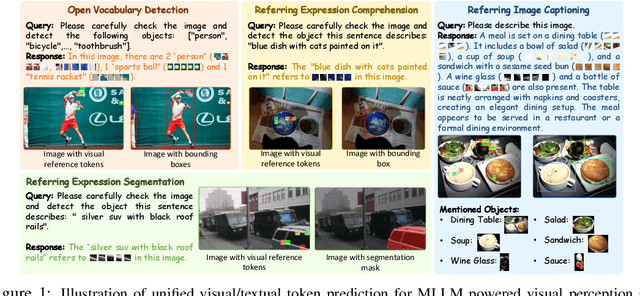
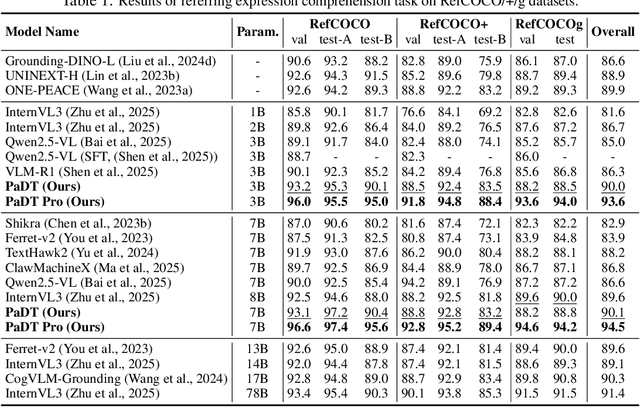
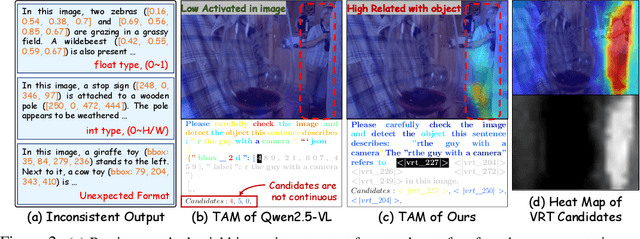
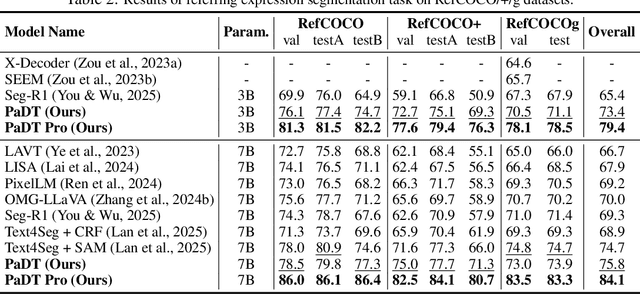
Abstract:Multimodal large language models (MLLMs) have advanced rapidly in recent years. However, existing approaches for vision tasks often rely on indirect representations, such as generating coordinates as text for detection, which limits performance and prevents dense prediction tasks like segmentation. To overcome these challenges, we introduce Patch-as-Decodable Token (PaDT), a unified paradigm that enables MLLMs to directly generate both textual and diverse visual outputs. Central to PaDT are Visual Reference Tokens (VRTs), derived from visual patch embeddings of query images and interleaved seamlessly with LLM's output textual tokens. A lightweight decoder then transforms LLM's outputs into detection, segmentation, and grounding predictions. Unlike prior methods, PaDT processes VRTs independently at each forward pass and dynamically expands the embedding table, thus improving localization and differentiation among similar objects. We further tailor a training strategy for PaDT by randomly selecting VRTs for supervised fine-tuning and introducing a robust per-token cross-entropy loss. Our empirical studies across four visual perception and understanding tasks suggest PaDT consistently achieving state-of-the-art performance, even compared with significantly larger MLLM models. The code is available at https://github.com/Gorilla-Lab-SCUT/PaDT.
Integrating SAM Supervision for 3D Weakly Supervised Point Cloud Segmentation
Aug 27, 2025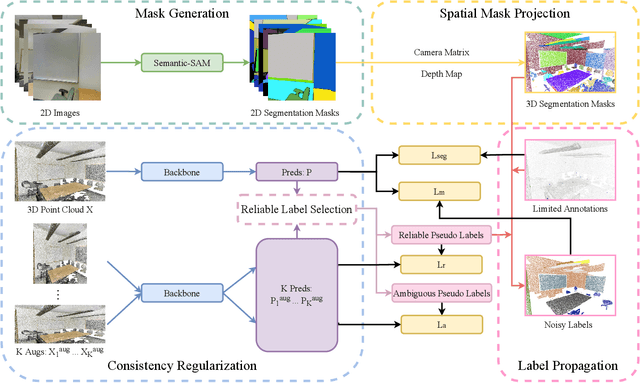
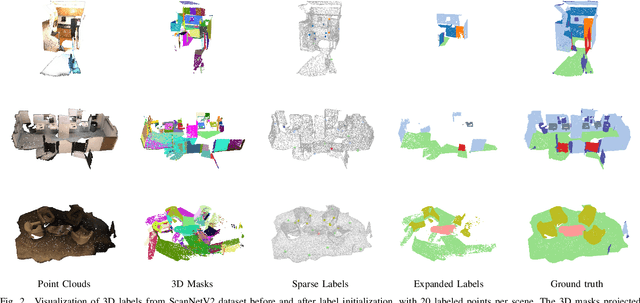
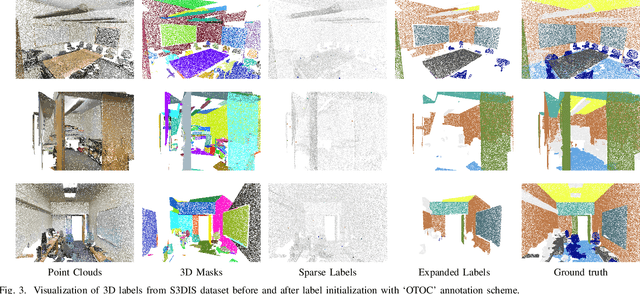
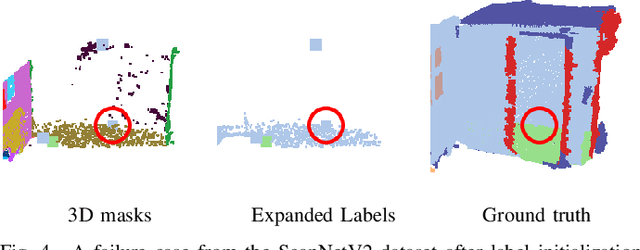
Abstract:Current methods for 3D semantic segmentation propose training models with limited annotations to address the difficulty of annotating large, irregular, and unordered 3D point cloud data. They usually focus on the 3D domain only, without leveraging the complementary nature of 2D and 3D data. Besides, some methods extend original labels or generate pseudo labels to guide the training, but they often fail to fully use these labels or address the noise within them. Meanwhile, the emergence of comprehensive and adaptable foundation models has offered effective solutions for segmenting 2D data. Leveraging this advancement, we present a novel approach that maximizes the utility of sparsely available 3D annotations by incorporating segmentation masks generated by 2D foundation models. We further propagate the 2D segmentation masks into the 3D space by establishing geometric correspondences between 3D scenes and 2D views. We extend the highly sparse annotations to encompass the areas delineated by 3D masks, thereby substantially augmenting the pool of available labels. Furthermore, we apply confidence- and uncertainty-based consistency regularization on augmentations of the 3D point cloud and select the reliable pseudo labels, which are further spread on the 3D masks to generate more labels. This innovative strategy bridges the gap between limited 3D annotations and the powerful capabilities of 2D foundation models, ultimately improving the performance of 3D weakly supervised segmentation.
FOCUS: Frequency-Optimized Conditioning of DiffUSion Models for mitigating catastrophic forgetting during Test-Time Adaptation
Aug 20, 2025Abstract:Test-time adaptation enables models to adapt to evolving domains. However, balancing the tradeoff between preserving knowledge and adapting to domain shifts remains challenging for model adaptation methods, since adapting to domain shifts can induce forgetting of task-relevant knowledge. To address this problem, we propose FOCUS, a novel frequency-based conditioning approach within a diffusion-driven input-adaptation framework. Utilising learned, spatially adaptive frequency priors, our approach conditions the reverse steps during diffusion-driven denoising to preserve task-relevant semantic information for dense prediction. FOCUS leverages a trained, lightweight, Y-shaped Frequency Prediction Network (Y-FPN) that disentangles high and low frequency information from noisy images. This minimizes the computational costs involved in implementing our approach in a diffusion-driven framework. We train Y-FPN with FrequencyMix, a novel data augmentation method that perturbs the images across diverse frequency bands, which improves the robustness of our approach to diverse corruptions. We demonstrate the effectiveness of FOCUS for semantic segmentation and monocular depth estimation across 15 corruption types and three datasets, achieving state-of-the-art averaged performance. In addition to improving standalone performance, FOCUS complements existing model adaptation methods since we can derive pseudo labels from FOCUS-denoised images for additional supervision. Even under limited, intermittent supervision with the pseudo labels derived from the FOCUS denoised images, we show that FOCUS mitigates catastrophic forgetting for recent model adaptation methods.
AD-FM: Multimodal LLMs for Anomaly Detection via Multi-Stage Reasoning and Fine-Grained Reward Optimization
Aug 06, 2025



Abstract:While Multimodal Large Language Models (MLLMs) demonstrate remarkable capabilities across diverse domains, their application to specialized anomaly detection (AD) remains constrained by domain adaptation challenges. Existing Group Relative Policy Optimization (GRPO) based approaches suffer from two critical limitations: inadequate training data utilization when models produce uniform responses, and insufficient supervision over reasoning processes that encourage immediate binary decisions without deliberative analysis. We propose a comprehensive framework addressing these limitations through two synergistic innovations. First, we introduce a multi-stage deliberative reasoning process that guides models from region identification to focused examination, generating diverse response patterns essential for GRPO optimization while enabling structured supervision over analytical workflows. Second, we develop a fine-grained reward mechanism incorporating classification accuracy and localization supervision, transforming binary feedback into continuous signals that distinguish genuine analytical insight from spurious correctness. Comprehensive evaluation across multiple industrial datasets demonstrates substantial performance improvements in adapting general vision-language models to specialized anomaly detection. Our method achieves superior accuracy with efficient adaptation of existing annotations, effectively bridging the gap between general-purpose MLLM capabilities and the fine-grained visual discrimination required for detecting subtle manufacturing defects and structural irregularities.
Exploring Active Learning for Label-Efficient Training of Semantic Neural Radiance Field
Jul 23, 2025Abstract:Neural Radiance Field (NeRF) models are implicit neural scene representation methods that offer unprecedented capabilities in novel view synthesis. Semantically-aware NeRFs not only capture the shape and radiance of a scene, but also encode semantic information of the scene. The training of semantically-aware NeRFs typically requires pixel-level class labels, which can be prohibitively expensive to collect. In this work, we explore active learning as a potential solution to alleviate the annotation burden. We investigate various design choices for active learning of semantically-aware NeRF, including selection granularity and selection strategies. We further propose a novel active learning strategy that takes into account 3D geometric constraints in sample selection. Our experiments demonstrate that active learning can effectively reduce the annotation cost of training semantically-aware NeRF, achieving more than 2X reduction in annotation cost compared to random sampling.
Zero-Shot 3D Visual Grounding from Vision-Language Models
May 28, 2025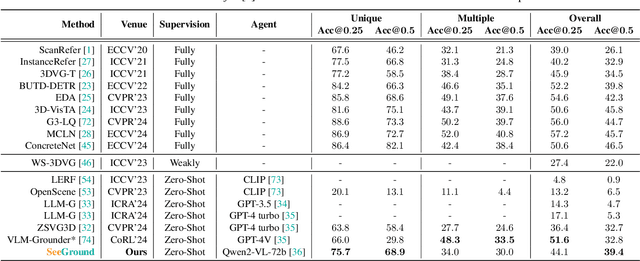
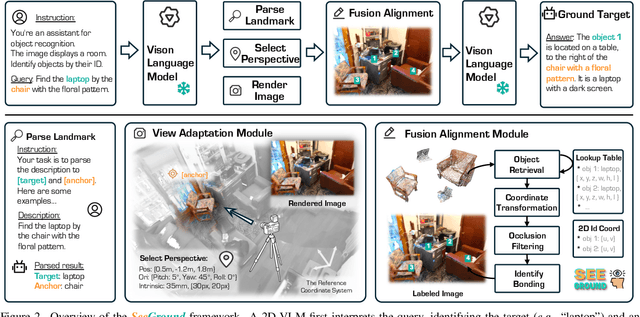
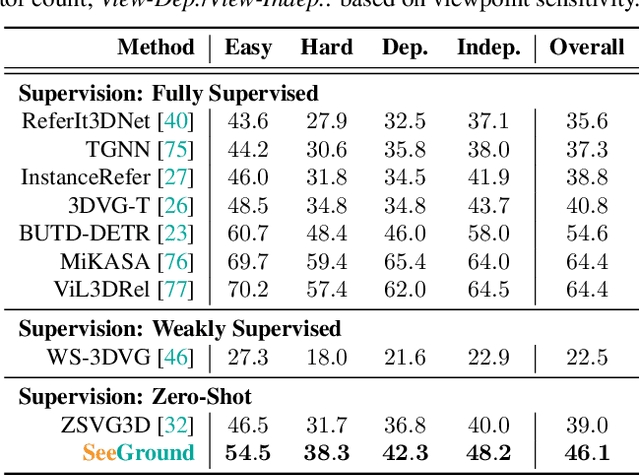
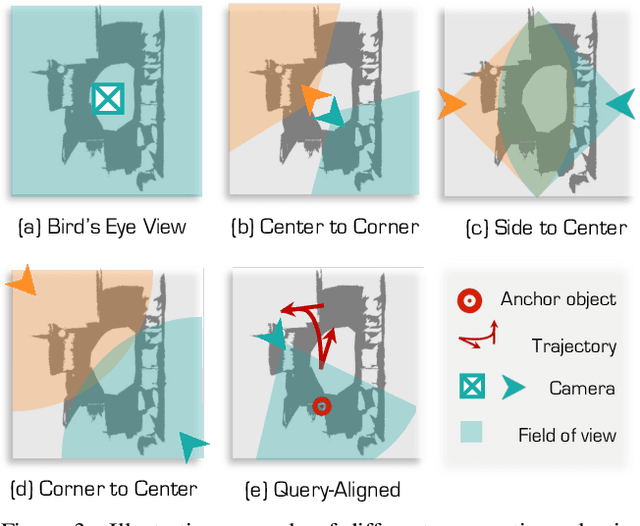
Abstract:3D Visual Grounding (3DVG) seeks to locate target objects in 3D scenes using natural language descriptions, enabling downstream applications such as augmented reality and robotics. Existing approaches typically rely on labeled 3D data and predefined categories, limiting scalability to open-world settings. We present SeeGround, a zero-shot 3DVG framework that leverages 2D Vision-Language Models (VLMs) to bypass the need for 3D-specific training. To bridge the modality gap, we introduce a hybrid input format that pairs query-aligned rendered views with spatially enriched textual descriptions. Our framework incorporates two core components: a Perspective Adaptation Module that dynamically selects optimal viewpoints based on the query, and a Fusion Alignment Module that integrates visual and spatial signals to enhance localization precision. Extensive evaluations on ScanRefer and Nr3D confirm that SeeGround achieves substantial improvements over existing zero-shot baselines -- outperforming them by 7.7% and 7.1%, respectively -- and even rivals fully supervised alternatives, demonstrating strong generalization under challenging conditions.
OccLE: Label-Efficient 3D Semantic Occupancy Prediction
May 27, 2025
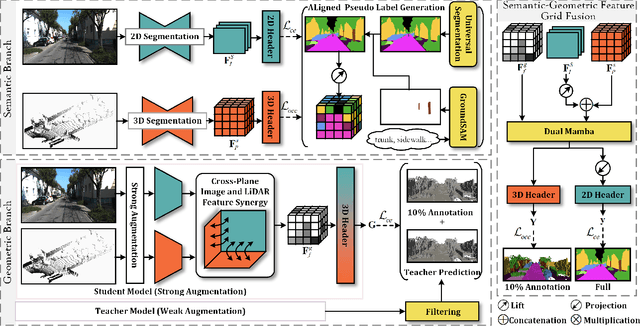
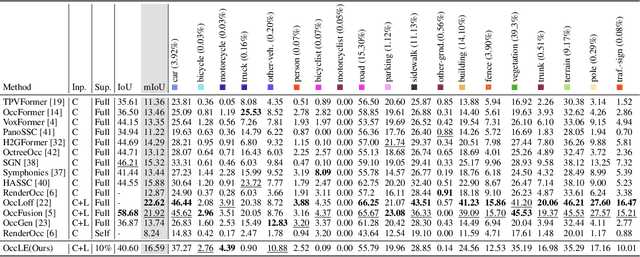

Abstract:3D semantic occupancy prediction offers an intuitive and efficient scene understanding and has attracted significant interest in autonomous driving perception. Existing approaches either rely on full supervision, which demands costly voxel-level annotations, or on self-supervision, which provides limited guidance and yields suboptimal performance. To address these challenges, we propose OccLE, a Label-Efficient 3D Semantic Occupancy Prediction that takes images and LiDAR as inputs and maintains high performance with limited voxel annotations. Our intuition is to decouple the semantic and geometric learning tasks and then fuse the learned feature grids from both tasks for the final semantic occupancy prediction. Therefore, the semantic branch distills 2D foundation model to provide aligned pseudo labels for 2D and 3D semantic learning. The geometric branch integrates image and LiDAR inputs in cross-plane synergy based on their inherency, employing semi-supervision to enhance geometry learning. We fuse semantic-geometric feature grids through Dual Mamba and incorporate a scatter-accumulated projection to supervise unannotated prediction with aligned pseudo labels. Experiments show that OccLE achieves competitive performance with only 10% of voxel annotations, reaching a mIoU of 16.59% on the SemanticKITTI validation set.
How Do Images Align and Complement LiDAR? Towards a Harmonized Multi-modal 3D Panoptic Segmentation
May 25, 2025Abstract:LiDAR-based 3D panoptic segmentation often struggles with the inherent sparsity of data from LiDAR sensors, which makes it challenging to accurately recognize distant or small objects. Recently, a few studies have sought to overcome this challenge by integrating LiDAR inputs with camera images, leveraging the rich and dense texture information provided by the latter. While these approaches have shown promising results, they still face challenges, such as misalignment during data augmentation and the reliance on post-processing steps. To address these issues, we propose Image-Assists-LiDAR (IAL), a novel multi-modal 3D panoptic segmentation framework. In IAL, we first introduce a modality-synchronized data augmentation strategy, PieAug, to ensure alignment between LiDAR and image inputs from the start. Next, we adopt a transformer decoder to directly predict panoptic segmentation results. To effectively fuse LiDAR and image features into tokens for the decoder, we design a Geometric-guided Token Fusion (GTF) module. Additionally, we leverage the complementary strengths of each modality as priors for query initialization through a Prior-based Query Generation (PQG) module, enhancing the decoder's ability to generate accurate instance masks. Our IAL framework achieves state-of-the-art performance compared to previous multi-modal 3D panoptic segmentation methods on two widely used benchmarks. Code and models are publicly available at <https://github.com/IMPL-Lab/IAL.git>.
Robust Distribution Alignment for Industrial Anomaly Detection under Distribution Shift
Mar 19, 2025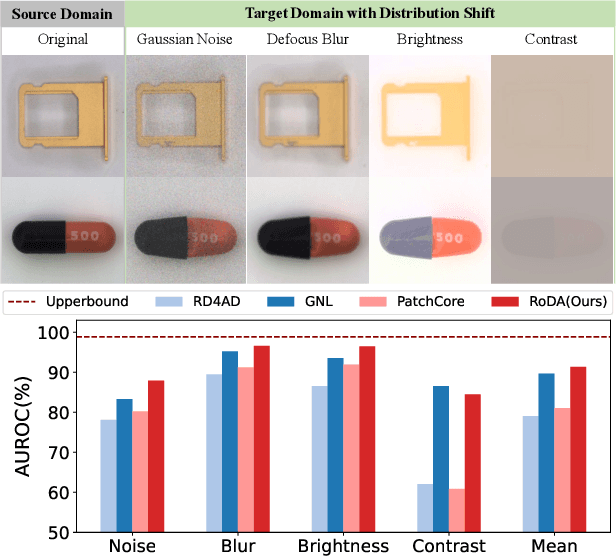

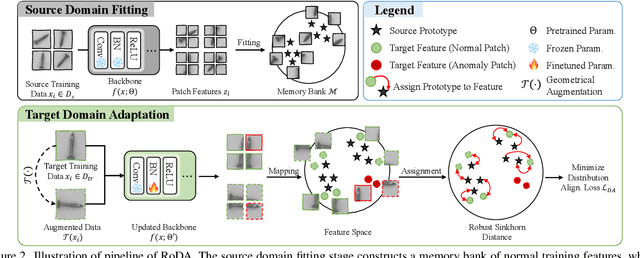

Abstract:Anomaly detection plays a crucial role in quality control for industrial applications. However, ensuring robustness under unseen domain shifts such as lighting variations or sensor drift remains a significant challenge. Existing methods attempt to address domain shifts by training generalizable models but often rely on prior knowledge of target distributions and can hardly generalise to backbones designed for other data modalities. To overcome these limitations, we build upon memory-bank-based anomaly detection methods, optimizing a robust Sinkhorn distance on limited target training data to enhance generalization to unseen target domains. We evaluate the effectiveness on both 2D and 3D anomaly detection benchmarks with simulated distribution shifts. Our proposed method demonstrates superior results compared with state-of-the-art anomaly detection and domain adaptation methods.
Multi-View Industrial Anomaly Detection with Epipolar Constrained Cross-View Fusion
Mar 14, 2025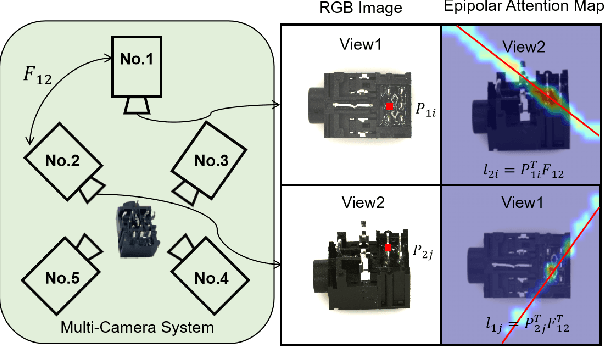
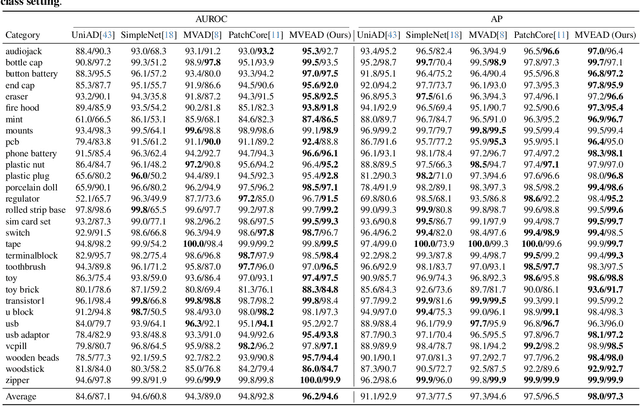

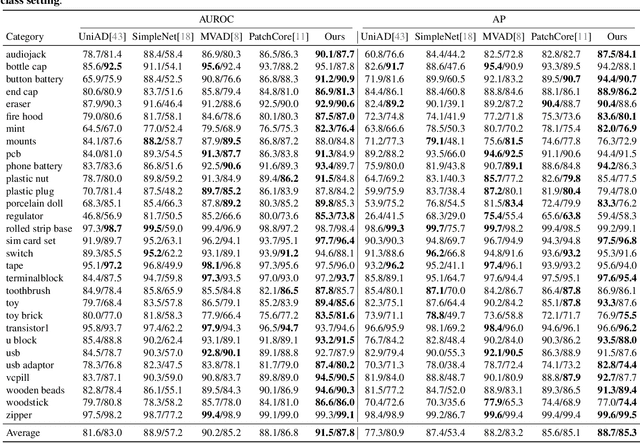
Abstract:Multi-camera systems provide richer contextual information for industrial anomaly detection. However, traditional methods process each view independently, disregarding the complementary information across viewpoints. Existing multi-view anomaly detection approaches typically employ data-driven cross-view attention for feature fusion but fail to leverage the unique geometric properties of multi-camera setups. In this work, we introduce an epipolar geometry-constrained attention module to guide cross-view fusion, ensuring more effective information aggregation. To further enhance the potential of cross-view attention, we propose a pretraining strategy inspired by memory bank-based anomaly detection. This approach encourages normal feature representations to form multiple local clusters and incorporate multi-view aware negative sample synthesis to regularize pretraining. We demonstrate that our epipolar guided multi-view anomaly detection framework outperforms existing methods on the state-of-the-art multi-view anomaly detection dataset.
 Add to Chrome
Add to Chrome Add to Firefox
Add to Firefox Add to Edge
Add to Edge